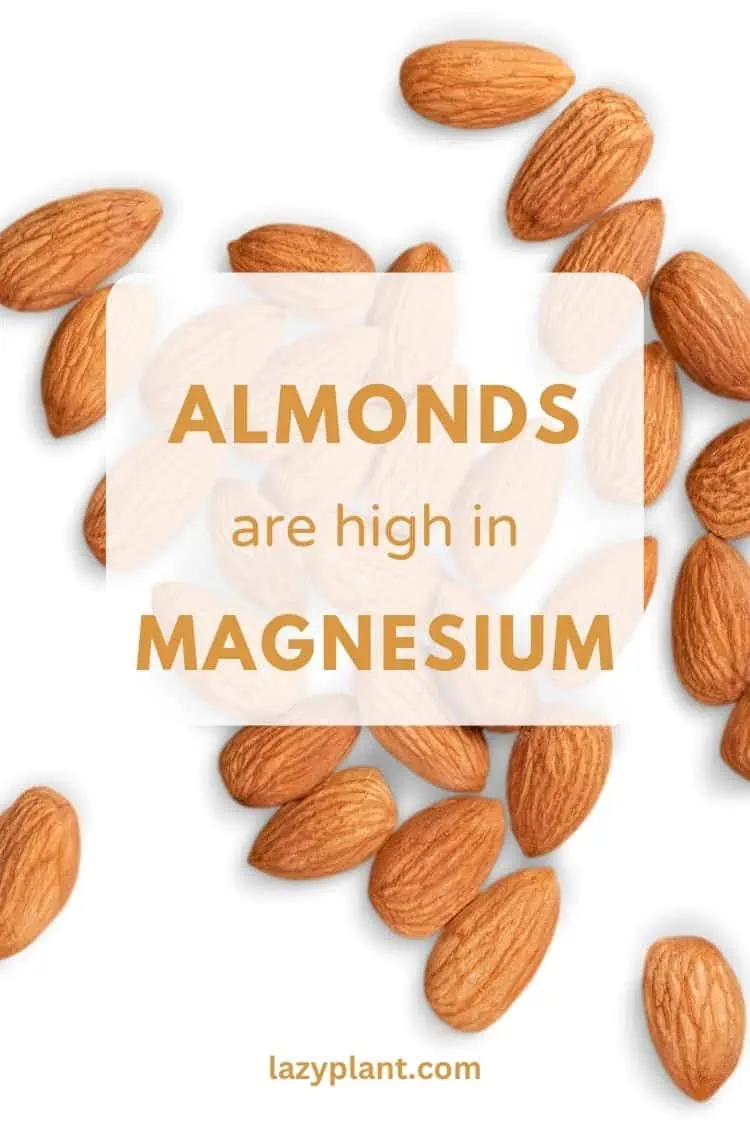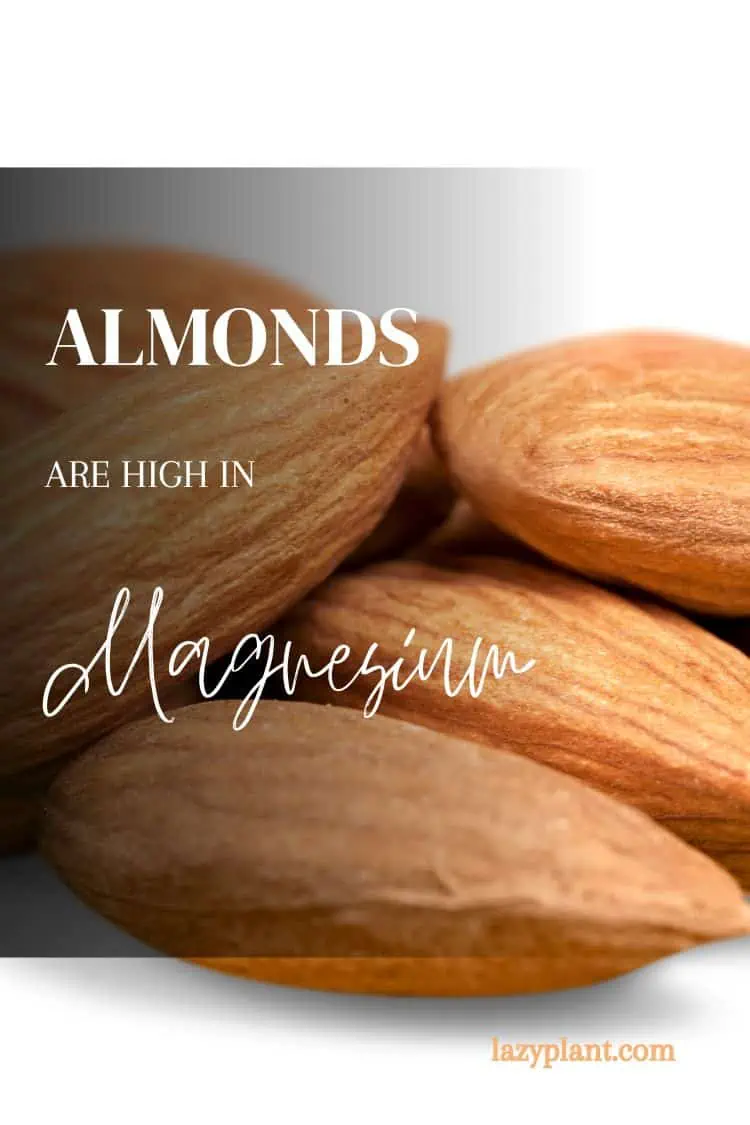Almonds are the richest nuts and one of the richest foods in magnesium! They help us meet our daily needs of magnesium, as a serving provides 18% of the recommended daily intake.
What’s the magnesium content of almonds?
Almonds have 270 mg of magnesium per 100g. They are an excellent dietary source of magnesium:
- a handful of almonds (about 23 almonds) has 76.5 mg of magnesium. This dose is 18% of the Daily Value.
- an almond has 3.24 mg of magnesium, or 0.7% of the DV.
- 5 almonds provide 16.2 mg of magnesium, or 4% of the DV.
- a medium serving of 10 almonds (1/2 handful) provides 32.4 mg of magnesium, or 8% of the DV.[1]
Is almond milk a good dietary source of magnesium?
Almond milk has only 7 mg of magnesium per 100 mL. It isn’t particularly rich in magnesium. A glass of almond milk provides 18 mg of magnesium. This dose is 4% of the recommended daily intake.
For comparison, cow’s milk has 12 mg of magnesium per 100 mL. It has 71% more magnesium than almond milk! A glass of cow’s milk provides 7% of the DV.

Other plant-based milks as well as cow’s milk have decent amounts of magnesium as well. They provide between 3-10% of the DV per serving.
Are other magnesium-based foods rich in magnesium?
Actually, most almond products are good dietary sources of magnesium. Only almond oil has no magnesium.
Almond flour is high in magnesium, providing more than 66% of the DV per 100g, or 17% of the DV per serving! For comparison, whole wheat flour contains only 136 mg of magnesium per 100g. It contains 46% less magnesium than almond flour. Refined flours have even less magnesium!
| magnesium (mg) per 100g | magnesium (mg) per serving | % DV | |
| butter | 279 | 45 | 11% |
| flour | 251 | 77 | 17% |
| paste | 130 | 37 | 9% |
| oil | 0 | 0 | 0% |
Moreover, almond flour has a better nutritional value than wheat flour. In fact, almond flour is much richer in calcium, vitamin E, and protein than common cereal flours!
Almond butter and paste are also good dietary sources of magnesium.
Do walnuts have more magnesium than other nuts?
Actually, almonds have the highest magnesium content as compared to other common nuts. Only cashews and pine nuts have a similar magnesium content to almonds, providing 18% and 17% of the required daily intake per serving, respectively.
However, hazelnuts, peanuts, walnuts, pecans, pistachios, and macadamia nuts are also magnesium-rich foods.
| magnesium (mg) per 100g | magnesium (mg) per serving | % DV | |
| almonds | 270 | 77 | 18% |
| cashews | 260 | 74 | 18% |
| pine nuts | 251 | 71 | 17% |
| hazelnuts | 173 | 49 | 12% |
| peanuts | 171 | 48 | 12% |
| walnuts | 158 | 45 | 11% |
| pecans | 121 | 34 | 8% |
| pistachios | 121 | 34 | 8% |
| macadamia nuts | 118 | 33 | 8% |
| chestnuts | 74 | 21 | 5% |
| Brazil nuts | 1.2 | 0 | 0% |
Do we absorb the magnesium of almonds?
It’s estimated that we absorb 30-50% of magnesium of food. The absorption rate depends on the consumed dose. We tend to absorb less magnesium when we get higher doses.[2]
How to eat almonds to increase the absorption rates of magnesium?
Above all, we should have normal vitamin D levels for optimal absorption of magnesium. Vitamin D at normal levels may enhance magnesium absorption. However, as vitamin D deficiency is pretty common, many people would benefit from taking high amounts of vitamin D from dietary supplements.[3]
Furthermore, we have to consume the recommended daily intake of calcium. Too little or too much calcium may negatively affect the absorption rate of magnesium. The calcium/magnesium ratio should be between 1.70 and 2.60.[4]
In addition, increased intakes of protein and fructose may improve magnesium absorption. Therefore, you should eat almonds and other magnesium-rich foods with fruits or high-protein snacks.[5]
What inhibits the absorption of magnesium of almonds?
We may absorb less magnesium from almonds, if:
- almonds are consumed with foods high in phytate. Actually, nuts are high in phytate. Soaking decreases the phytate content of almonds and other nuts!
- get high doses of zinc or vitamin D
- smoke
- drink too much alcohol
- take certain drugs
What’s the recommended daily intake?
The recommended daily intake of magnesium is approximately 400-420 mg for adult men and 310-320 mg for adult women. Teenagers and pregnant women have high magnesium needs (360-410 mg) as well. Children require lower dosages.[6]
Do almonds help us meet our daily needs?
Certainly, almonds are one of the richest foods in magnesium. Almonds can help us meet our daily needs of magnesium, as a handful provides 18% of the recommended daily intake. However, you shouldn’t consume more than a serving per day. Almonds can make you gain weight because they have many calories.
However, reasonable amounts of almonds can help you lose weight. The best time to eat almonds for weight loss is between meals as a healthy snack, or before a high-calorie meal. Fiber and protein in almonds promote satiety. Hence, almond consumption regulates energy intake!
Can we get too much magnesium from almonds?
Healthy people can’t get too much magnesium from almonds. In fact, there hasn’t been established a maximum safe dose of magnesium for food. The kidneys eliminate excess amounts in the urine.

However, people with impaired kidney function or kidney failure may accumulate too much magnesium from magnesium-rich foods like almonds, as their kidneys can’t properly remove the excess. Additionally, almonds can be dangerous for some individuals. Among others, they are a common allergen.
Always consult your physician before changing your diet or taking dietary supplements.
Other common foods high in magnesium
Magnesium is naturally found in both animal (e.g. fish) and plant-based foods, as well as certain beverages. Green leafy vegetables, beans, legumes, nuts, seeds, whole grains, and certain fruits are good sources of magnesium. In general, foods high in fiber are also high in magnesium.
Pumpkin seeds, chia seeds, almonds, and spinach are the richest common foods in magnesium. They provide 19-37% of the recommended daily intake per serving!
Moreover, banana and avocado are the richest fruits in magnesium.
Whole grains have decent amounts of magnesium as well. On the contrary, refined grains contain negligible amounts of magnesium. The removal of the nutrient-rich germ and bran substantially decreases the magnesium content of the grain.
In addition, tap, mineral, and bottled water can be good sources of magnesium. But the amount of magnesium in water significantly varies. It ranges from 1 mg per liter to more than 120 mg per liter!
Dietary surveys in the United States consistently show that many people consume less than the recommended daily intake of magnesium. But, following a well-balanced, plant-based diet provides more than enough magnesium.